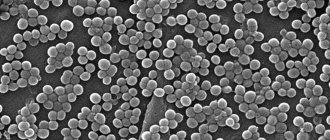Herpes in dogs is a dangerous viral infection, fundamentally different from its human counterpart. Hiding in the DNA of the infected person, the causative agent of this disease deceives the immune system for a long time. Without noticing anything dangerous, the body does not fight the virus and does not send signals for help. Because of this, the disease is asymptomatic until the appearance of serious disorders that threaten the life of the animal.
What is herpes in dogs: explanations and photos
The herpes virus (CHV-1) affects the upper respiratory tract in dogs: the nasal passages and pharynx. In puppies under 3 weeks of age, the disease occurs in an acute form. They often die from lack of oxygen and internal hemorrhages. It is almost impossible to save an infected pet.
Puppies over 3 weeks of age experience a milder form of the infection. With timely treatment, owners can hope that the babies will get better.
The asymptomatic form is typical for adult pets. Despite its rather slow development, the infection affects most vital organs and systems. To avoid complications, you should seek help immediately after the first alarming changes appear.
After the symptoms disappear and the sick dog’s condition normalizes, the disease passes into a latent form. For this reason, every second four-legged pet in the world is a carrier. Such an animal continues to infect others without experiencing the negative effects of the virus on its own body. Despite this, stress and the use of certain medications can activate the pathogen, which will be noticeable by the sudden appearance of clinical signs.
Signs and symptoms
The clinical manifestations of herpes vary depending on the age of the dog. Newborn puppies have a variety of symptoms that are pronounced. From the moment of infection until the appearance of external manifestations of herpes, viruses actively multiply and spread through the blood throughout the body.
In recently born puppies, herpes develops at lightning speed. Their immune system does not have time to react and respond to the infection. Body temperature usually does not rise, which allows viruses to spread freely throughout the body. The disease lasts for 2-3 days. About 80% of puppies die during this time.
Characteristic symptoms of herpes in puppies:
- foci of inflammation in the pharynx, tonsils;
- cough;
- sneeze;
- weakness;
- poor appetite;
- decreased sucking reflex;
- constant whining;
- yellow softened stool;
- the appearance of hematomas due to increased vascular permeability.
In puppies that are more than 1-2 months old, herpes occurs in a milder form. Fatalities are rare. But dogs become a source of hidden infection. In adults, the sexual form of herpes most often manifests itself.
The disease can be suspected based on characteristic signs:
- ulcers, erosions on the genitals (in males - on the foreskin, in females - inside the loop);
- frequent abortions, imaginary false pregnancies are observed, the born offspring in most cases do not survive;
- frequent vaginitis, endometritis;
- There may be a fever and an increase in temperature, which is not recommended to be brought down until there is a threat to the dog’s life.
If the airways are affected, you may experience:
- cough;
- snot;
- bronchitis;
- difficulty breathing, shortness of breath;
- severe wheezing.
Note! Herpes skin lesions occur under the guise of herpes zoster. Sores may appear on different parts of the body. At first these are small bubbles filled with transparent exudate. Then they burst, forming weeping wounds. The dog may scratch the skin vigorously, creating conditions for secondary bacterial infection.
Danger of the virus for the animal
Maximum mortality is typical for infection in the womb. CHV-1 causes spontaneous abortion or stillbirth. If the puppies still manage to survive, they die within 24 hours in 98% of cases. The newborn's immunity is very weak and is not able to fight off infection with antibodies. For this reason, the diagnosis is often made posthumously.
Herpesvirus infection in dogs is very contagious and can cause a number of complications:
- sudden weight loss;
- stomach ache;
- breathing problems;
- heart and liver failure;
- gastrointestinal disorder;
- bronchitis, pneumonia and rhinitis;
- hypersalivation;
- convulsions and attacks of suffocation.
The more concomitant disorders are identified, the lower the chances of salvation. It is much safer to prevent infection by avoiding the main routes of transmission of the virus.
Symptoms of the disease in adult dogs
Adult dogs also suffer from the introduction of the herpes virus into their bodies:
- Most often, the animal's genitals are affected . Symptoms of the disease appear only when the disease begins to progress. Male dogs are diagnosed with genital herpes. It manifests itself in the form of ulcers on the foreskin, which can be noticed when it is rolled away. In females, genital herpes is very difficult to notice at home. The ulcers are located inside the loop, which makes them invisible to humans.
- Less commonly, the herpes virus affects the respiratory tract . Breathing problems appear, and coughing is very common. May cause concern: rhinitis, conjunctivitis, bronchitis with sputum discharge. The cough is so severe that it may be accompanied by vomiting. As pneumonia develops, the animal may wheeze. Every breath is difficult for him. Mucus accumulates in the lungs. Signs of oxygen starvation appear.
- False pregnancy or dissolved fetuses in dogs indicate the presence of a herpes virus infection in the body . The female may give birth to stillborn puppies. At the same time, the infected female is no different from a healthy animal; she has no symptoms of the disease.
- The herpes virus can cause febrile conditions in animals . In this case, you cannot lower the temperature unless there is a threat to the pet’s life.
- Herpes ulcers can appear in completely unexpected places : for example, on the face of an animal. An ulcer is a collection of small blisters filled with transparent contents. Once the blisters are damaged, this area of skin becomes a wound with a weeping surface. Painful ulcers can appear in the dog’s mouth: on the roof of the mouth, tongue, and gums.
The virus affects the respiratory tract and causes coughing.
Skin lesions on the body look like shingles. Sores with liquid contents are visible in the area of the ribs or abdomen. The animal constantly scratches them, which causes hair loss, reminiscent of lichen.
How can you get infected?
There are a lot of herpes viruses. Scientists have proven that humans cannot become infected from animals, and dogs do not get sick from the cat virus. Cats do not get the virus from dogs.
It is possible to become infected with the virus through airborne droplets.
Infection of dogs occurs from a sick pet to a healthy one in the following ways:
- Airborne . In this case, it is enough to sneeze a couple of times for the dog to become infected.
- By eating from a shared bowl, it is quite possible to become infected with the herpes virus . This route of infection is considered to be through household contact. The herpes virus can lie in wait everywhere: on the owner’s hands, on common bedding, on furniture, carpets and clothes.
- During sexual intercourse.
- Offspring become infected from an infected mother .
Causes of appearance and routes of infection
Herpesvirus in dogs is transmitted in 4 ways. These include:
- Sexual
. In addition to sperm, other fluids from the genitals are also dangerous. Before ejaculation, vaginal lubricant or pre-ejaculate may enter a small wound on the genitals.
- Antenatal and intranatal
. Puppies become infected either through the placenta or during passage of the birth canal. Females get sick more often than males, so it is very important to carefully check the pet and her partner before and after mating.
- Airborne
. The pathogen enters the body along with the saliva and sputum of an infected animal.
- Contact and household
. Infection occurs through the patient's personal belongings: feeders, water bowls, bedding, toys and combs. Direct contact is not necessary, so CHV-1 particles can appear in the house on the clothes, shoes or hands of the owner. If you pet a stray or someone else's dog, be sure to wash your hands before touching your pet.
The risk group includes animals from shelters, kept in crowded conditions, and pets with a good pedigree. If your four-legged pet participates in exhibitions or often visits places where mass pets are walked, then the likelihood of infection for him is no less than for those who live in a shelter.
Causes of stomatitis in dogs
Stomatitis is an inflammation of the mucous membranes of the mouth. Most often it occurs on the membranes of the lips and cheeks. Inflammation of tissues is accompanied by wounds and ulcers, and sometimes very deep erosions. They may be covered with plaque or pus.
Most dogs with this disease have no obvious clinical signs. A biopsy often shows typical collections of lymph and blood plasma (infiltrates) in inflamed areas, but may also reveal necrotic lesions in the center of a wound or ulcer. Although dogs may not show obvious clinical signs, pain is always present. This is discovered as soon as the pet begins to eat food selectively, and sometimes even refuses food altogether.
Important! The symptoms of canine stomatitis are similar to those of gingivitis, although the former is a more common inflammation that affects other areas of the mouth, not just the gums.
The reason for its appearance is unknown. Veterinarians believe that this is an allergic reaction to the formation of plaque, which is a soft material made from saliva and food debris that remains on the teeth after eating. The animal cannot brush its teeth. Its functions are performed by cartilage and bones. If there are not enough of them in the food, then after 4-5 days the plaque turns into tartar.
Other causes of stomatitis:
- mechanical trauma to the gums;
- cold or too hot food;
- injuries from exposure to chemically active substances: household chemicals, drugs, poisons;
- periodontal diseases;
- infections;
- diseases of the endocrine system;
- pathologies of the gastrointestinal tract (gastrointestinal tract);
- metabolic disorders;
- immunodeficiency.
Stomatitis can occur in adult dogs of any breed or age. But terriers and Maltese dogs have a genetic predisposition to inflammation of the mucous membranes.
Injuries and damages
A dog can injure the mucous membrane:
- while eating a piece of bone;
- with a stick while playing outside;
- in a dog fight;
- another way.
Typically, her wounds should heal quickly unless they are complicated by infection. When a puppy changes teeth or when developing a bite, problems can also arise.
Diseases
Diseases that can become the root cause of inflammatory processes:
- diabetes;
- allergy;
- autoimmune disorders;
- lymphoma is a disease of lymphatic tissue;
- hormonal disorders;
- nephritis;
- osteomyelitis;
- hypereosinophilic syndrome.
For some diseases, stomatitis is a secondary disease. For example, osteomyelitis is more common in Greyhounds, Labradors, Maltese and Miniature Schnauzers. Hyperosinophilic syndrome is common in Alaskan Malamutes, Cavalier King Charles Spaniels, German Shepherds, Italian Greyhounds, Rottweilers, and Siberian Huskies.
Infections
Infectious diseases appear due to the penetration of infection into the body. A strong immune system will destroy the pathogen, but a weakened one cannot always effectively resist it. Causes include bacterial, parasitic or fungal infections.
The main infectious diseases accompanied by stomatitis:
- leukemia;
- infectious hepatitis;
- leptospirosis;
- herpes;
- plague;
- parovirus enteritis.
Important! A bacterial infection in the mouth is not harmless. From there, bacteria enter the bloodstream, which leads to infection of other organs and new diseases.
Fungal diseases
Fungal stomatitis occurs due to fungi of the genus Candida. Puppies and adult dogs can be affected by the disease. They have weak immunity, and this contributes to the development of various pathologies. A characteristic sign of candidal stomatitis is a cheesy coating on the oral mucosa.
Other pathologies
Your pet may accidentally ingest a toxic substance or lick anti-flea spray from its fur. Risk factors include hot food, hot steam and other oral trauma, which leads to illness.
Symptoms of herpes in dogs
Symptoms and treatment of herpes virus infection in dogs depend on the number of systems affected. In addition to the respiratory system, the gastrointestinal tract, nervous system, musculoskeletal system and genitals may be affected. The latter is typical exclusively for adult animals, since most often they become infected during mating.
At first, all changes are limited to decreased activity and poor appetite. More serious violations do not appear soon, but develop very rapidly. These include:
- temperature rise above 40 °C;
- redness and swelling of the mucous membranes of the genital organs and oral cavity;
- severe wet cough accompanied by gagging;
- transparent blisters on the face and genitals, causing the development of severe itching and weeping eczema;
- redness of the eyes and increased tearing;
- partial or complete loss of hair on the stomach and paws;
- mucous discharge from the nose;
- blue mucous membranes.
In puppies infected in the womb, symptoms appear more quickly—about a week after birth. During this time, the virus, which has not met defense, manages to disperse to all vital organs. A sick baby appears:
- severe lethargy (he moves little and sleeps constantly);
- shortness of breath with any exertion (even when trying to drink milk);
- cough, runny nose and sneezing;
- abdominal pain;
- swelling and hematomas due to increased vascular permeability (part of the plasma may appear on the surface of the skin);
- accumulation of ulcers in the mouth and nose;
- yellow diarrhea.
Fever is not observed in puppies, since the thermoregulation of their body has not yet been established. High temperature is the main way the immune system fights various pathogens, but in the case of young animals it does not work.
Bacterial skin diseases in dogs with symptoms and photos
Bacterial infections are not only secondary, but also primary. Most often they are provoked by streptococci and staphylococci, which enter the body through minor injuries. For effective treatment, you need to know the exact type of pathogen, since prolonged treatment with broad-spectrum antibiotics greatly weakens the body.
Streptococci
Most often, these bacteria cause folliculitis. It is accompanied by the formation of red spots or nodules around the hairs. Over time, the formations are filled with yellowish-green pus, and their opening when scratching leads to severe peeling and hair loss.
Staphylococcus
The most dangerous representative is Staphylococcus aureus. It is easily distinguished by frequent vomiting and diarrhea, which quickly dehydrate the body.
Without timely help, bacteria spread through the bloodstream, increasing the affected area. In addition to numerous boils and erosions, infection with staphylococci is fraught with inflammation in the ears, vaginitis, endometritis and pyometra.
Difficulties in making a diagnosis
Due to frequent mutations, it is very difficult for veterinarians to determine not only the stage of infection, but also the very presence of the herpes virus in dogs. Vague symptoms and rare manifestations of the disease, similar to many other pathologies, complicate diagnosis even more.
Most often the diagnosis is made posthumously. At autopsy, infected animals are found to have numerous hemorrhages, necrotic changes in most internal organs, and an enlarged spleen and lymph nodes.
During the appointment, the four-legged patient must undergo a blood test. Using the resulting sample, you can determine the presence or absence of antibodies to the pathogen. Such a study often gives false positive results, so it is repeated after 2 weeks.
Additionally, it is recommended to take a biopsy from the nose or genitals for the purpose of conducting a PCR study. This diagnostic method is more informative, as it allows you to detect the DNA of the virus.
Diagnosis and treatment
Herpes is not so easy to diagnose, since it manifests itself under the guise of symptoms of various ailments. To identify it, various studies are carried out in laboratories and veterinary clinics. Blood, genital secretions, nose and eyes are examined.
Sometimes, to detect pathology, tests are repeated after half a month. In older animals, infection is difficult to detect, because the virus in their body, as already noted, does not show resistance. And the disease itself is asymptomatic. Based on the diagnostic results, the veterinarian prescribes medications if necessary.
There is no specific treatment for herpes in dogs. According to indications, the veterinarian may administer hyperimmune serum (usually this happens at the initial stage of the pathology) or prescribe antimicrobial drugs. It happens that ointments, eye drops, and other medications are used for treatment; symptomatic therapy for cough, rhinitis, etc. is carried out.
Puppies born from an infected dog require special care and treatment. They are warmed and treated with antiviral drugs and supportive care. But all this does not guarantee that they will remain alive. Treating herpes in dogs is not easy. Therefore, at the first symptoms of malaise, you should seek help from specialists. Only they can determine whether additional treatment is needed or whether the body itself is able to overcome the infection.
The main thing to pay attention to is the possibility of preventing further spread of the viral infection. To this end, at the first manifestations of illness, it is necessary to limit the contact of the sick pet with other animals and especially puppies.
Is it possible to completely cure a dog of the virus?
There is no specific treatment for the herpes virus in dogs. The therapy used is aimed solely at relieving symptoms and strengthening the immune response.
Therapy
Antiviral drugs, which reduce the activity of the pathogen, and antibiotics, which relieve complications, are used as drug therapy. Thanks to these drugs, the disease becomes chronic (latent) form.
Treatment of newborns rarely gives positive results. If babies manage to survive the first 2 days, they can die from numerous disorders in the kidneys, respiratory and nervous systems. For this reason, veterinarians are in no hurry to give a prognosis in the first weeks.
Surviving puppies will have to be examined regularly to suppress further virus activity as soon as it is detected. Sick pets should not be sent to kennels, as this can result in mass infection. Future owners should also talk about the problem if the babies are going for sale.
A similar regimen is used to treat adults. In addition to the listed drugs, sick animals are prescribed immunomodulators, vitamins and infusion therapy to eliminate the effects of dehydration.
Care and prevention measures
To eliminate itching and heal ulcers, the skin and mucous membranes are treated with special ointments and gels. Sick puppies are placed in a warm and dry room with a temperature of at least 30°C. For warming up, infrared lamps and heating pads are used.
Due to the variability of transmission methods, it is impossible to protect against infection 100%. Owners of four-legged pets can only follow the recommendations aimed at reducing the existing risk:
- Do not allow breeding and refuse to participate in exhibitions if your pet has ever had ulcers on its face. These measures will help prevent the spread of herpesvirus.
- Make sure each pet has its own personal belongings. Avoid feeding from the same bowl or brushing the fur with the same furminator. While walking, stop picking up other people's things left on the ground.
- Provide the most favorable living conditions for puppies born from an infected mother. Monitor their well-being and immediately contact a veterinarian at the first sign of discomfort.
- Get preventive examinations annually. Treat diseases immediately after they appear, avoiding contact with other animals until recovery.
- Take a blood test for herpesvirus before each mating and check the results of a similar study with your chosen partner.
- Maintain quarantine 3 weeks before mating and 3 weeks after birth. Avoid contact with potential carriers by walking your pet in a fenced area.
- Do not interact with other people's animals or bring home new ones without checking their health with a veterinarian.
To prevent the herpes virus in pregnant dogs, Eurican is used. This French vaccine helps develop an immune response, preventing contamination of the litter. Passive immunity is often passed on to newborns, reducing the risk of infection to approximately 1 month.
In the future, the vaccine is given twice before reaching the age of one year. The vaccine is then administered once and annually. It is not mandatory, since in adulthood it simply smoothes out symptoms. This further complicates timely diagnosis, so veterinarians recommend vaccinating only puppies and pregnant bitches.
Can a person infect a dog or vice versa?
CHV-1 is found only in the canine family, so it is safe for other pets and humans. Combing fur and treating sores is completely safe. It remains to be seen whether a dog itself can become infected with the herpes virus from a person.
The human herpesvirus is no less selective, so it is found only in humans. Transmission of herpes virus infection from person to pet occurs only through dirty hands and items of clothing infected with CHV-1. For this reason, it is very important to maintain hand hygiene when returning home from the street, and to store shoes and street clothes out of reach of the dog.
The herpes virus in dogs requires constant monitoring and prevention. Remember that a sick pet should no longer be allowed to breed or participate in dog shows. Regular checkups with your veterinarian and minimizing contact with other animals will help reduce the number of infestations.
The article is for informational purposes only. Contact your veterinarian!
Can a dog get infected from a person?
Fortunately, this is not possible. A four-legged pet infected with herpes is also not dangerous for humans or other animals, since the virus is specific in dogs and is dangerous only for other dogs.
We recommend reading: Why the Cat Was Drooling a Lot
Important! There may be cases of pet infection when the owner transfers herpes from the street on outer clothing. But the likelihood of such an outcome is low, since herpes does not live long outside the body.











